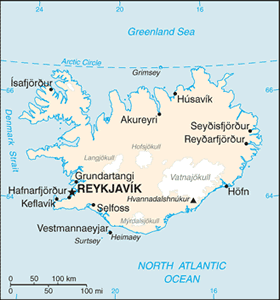The Geography of Iceland
The Geography of Iceland
Icelandic Geography
Location: Northern Europe, island between the Greenland Sea and the North Atlantic Ocean, northwest of the United Kingdom
Geographic coordinates: 65 00 N, 18 00 W
Map references: Arctic Region
Area: total: 103,000 sq km land: 100,250 sq km water: 2,750 sq km
Area - comparative: slightly smaller than Kentucky
Land boundaries: 0 km
Coastline: 4,970 km
Maritime claims: territorial sea: 12 nm exclusive economic zone: 200 nm continental shelf: 200 nm or to the edge of the continental margin
Climate: temperate; moderated by North Atlantic Current; mild, windy winters; damp, cool summers
Terrain: mostly plateau interspersed with mountain peaks, icefields; coast deeply indented by bays and fiords
Elevation extremes: lowest point: Atlantic Ocean 0 m highest point: Hvannadalshnukur 2,110 m (at Vatnajokull glacier)
Natural resources: fish, hydropower, geothermal power, diatomite
Land use: arable land: 0.07% permanent crops: 0% other: 99.93% (2005)
Irrigated land: NA
Natural hazards: earthquakes and volcanic activity
Environment - current issues: water pollution from fertilizer runoff; inadequate wastewater treatment
Environment - international agreements: party to: Air Pollution, Air Pollution-Persistent Organic Pollutants, Biodiversity, Climate Change, Climate Change-Kyoto Protocol, Desertification, Endangered Species, Hazardous Wastes, Kyoto Protocol, Law of the Sea, Marine Dumping, Ozone Layer Protection, Ship Pollution, Transboundary Air Pollution, Wetlands, Whaling signed, but not ratified: Environmental Modification, Marine Life Conservation
Geography - note: strategic location between Greenland and Europe; westernmost European country; Reykjavik is the northernmost national capital in the world; more land covered by glaciers than in all of continental Europe


